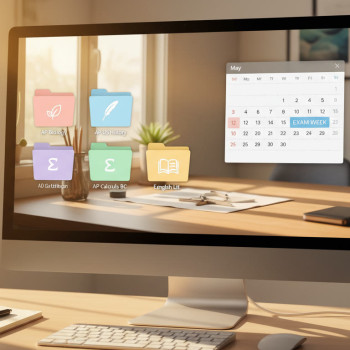Why ‘Reset Protocols’ Matter—Beyond Simple Breaks
Breaks are not just tiny pauses between questions or sections. For an AP student, a break is a strategic reset—an opportunity to change pace, re-center thinking, and prepare your mind and body for the next stretch of high-focus work. Done well, a five- or ten-minute reset can mean the difference between muddled concentration and sharp performance. Done poorly, it can become a derailment: stress spirals, rule violations, or wasted time.

The two ways to think about resets
There are two distinct moments where reset protocols help most:
- During practice and study blocks: the short daily resets that keep you fresh across weeks of AP preparation.
- During exam-day breaks: the strict, rule-bound pauses between sections that must protect both your performance and exam integrity.
In this post we’ll cover both—how to design micro-routines during studying, and how to follow practical, policy-aware reset steps on exam day so you come back calm, clear, and rule-compliant.
Exam-Day Realities: Rules You Can’t Ignore
Before you build any reset ritual for test day, understand the constraints. AP exams are governed by clear policies: you cannot consult notes, use electronic devices, leave the building, or communicate about exam content during breaks. Some students may have approved accommodations for extra breaks, but those are formal and require documentation.
Why emphasize rules? Because a well-designed reset protocol is not only about feeling better—it’s also about staying within the rules so your scores remain valid. Reset smart, not risky.
Key exam-day boundaries to remember
- No electronic devices of any kind during testing or breaks.
- Don’t consult books, notes, or teachers about exam questions during breaks.
- Stay in the designated testing area or building unless you have explicit permission or accommodation.
- If you have a disability that requires extended or additional breaks, those must be approved in advance through the accommodations process.
Designing Your Personal Reset Protocol for Study Days
Study resets are the training ground for exam-day composure. The goal: teach your brain to switch off, recharge, and return to focused work without losing momentum.
Core elements of every effective micro-reset
- Time box it: Give yourself a fixed window—3, 5, or 15 minutes depending on the break length. Sticking to the clock reduces guilt and friction when it’s time to resume.
- Movement: A short walk, stretches, or a few bodyweight moves get blood flowing and clear mental fog.
- Breath and posture: Two minutes of simple breathing (inhale for 4, exhale for 6) and posture checks help drop cortisol spikes.
- Hydration and fuel: Sip water or have a small, planned snack. Avoid heavy meals mid-block; opt for balanced, low-glycemic bites that won’t induce drowsiness.
- Single-task reset: Do one brief non-academic activity—a short sketch, a quick puzzle, or 60 seconds of mindful listening to a favorite song.
Sample 10-minute study-block reset (easy to train)
- 00:00–00:30 — Stand up, shake out limbs.
- 00:30–02:30 — Walk outside or around your home; focus on the senses (what you smell/feel).
- 02:30–04:30 — Two minutes of deep breathing and posture reset.
- 04:30–06:30 — Hydrate and eat one small bite (e.g., nuts, banana).
- 06:30–09:00 — 2.5 minutes of a micro-challenge (a math puzzle unrelated to AP topic, quick sketch).
- 09:00–10:00 — Set one clear intention for the next study block (one sentence).
Reset Protocols During Official AP Exam Breaks
Exam-day reset protocols must be simple, quick, and rule-abiding. The mental aim is identical—reduce anxiety and reorient attention—but the operational constraints are tighter.
What to do (and not do) between AP exam sections
- Do: Stand, breathe, and move gently in place. Short walks inside the designated area are usually allowed if the proctor permits and you remain on-site.
- Do: Hydrate with plain water if permitted and if you have it with you before the exam begins (note that bringing items into the room might be restricted—follow proctor instructions).
- Do: Use a private mental routine—counted breaths, a two-phrase mantra, or a rapid body scan—that fits in one to five minutes.
- Don’t: Use phones or devices, consult notes, or talk about anything related to the test content.
- Don’t: Leave the building or designated area without authorization.
A concise, exam-safe reset routine (2–5 minutes)
- Minute 0: Close your eyes and take three deep, slow breaths (inhale 4, exhale 6).
- Minute 1: Perform a quick posture reset: shoulders back, chin slightly down.
- Minute 1–2: Run a simple mental checklist: “Breath — Ready. Focus — 1 key idea. Strategy — start with easy questions.”
- Minute 2–3: Visualize the first 60 seconds of the next section going well: calm breathing, clear thinking, steady pace.
- Return: Open your eyes and begin with a simple warm-up question or quick scan of the section.
Table: Quick Comparison—Study Breaks vs Exam Breaks
| Element | Study Break (Training) | Exam Break (Test Day) |
|---|---|---|
| Duration | 3–20 minutes (flexible) | 1–10 minutes (strictly enforced) |
| Allowed activities | Any reset activity; short phone use OK | Movement, breathing, hydration (device use prohibited) |
| Mental goal | Refresh and build stamina | Stabilize, calm, and focus—without external input |
| Risk | Low—possibility of distraction | High—policy violations can cancel scores |
Training Your Reset Muscle: Practice Makes Protocol
Like any test strategy, reset protocols are skills you should practice. Try integrating them into your daily study plan to build automaticity so, on exam day, the routine feels natural rather than forced.
Weekly practice plan (4-week cycle)
- Week 1 — Experiment: Try 3 different micro-resets during study sessions to see which relaxes you fastest.
- Week 2 — Habit: Choose one reset and use it for every study session that week.
- Week 3 — Time pressure: Use the reset during timed practice tests to simulate exam conditions.
- Week 4 — Fine-tune: Adjust based on what improved your concentration and what didn’t.
Rotate through different sensory cues (sound, movement, breath) and notice how long the positive effects last. If a 5-minute reset keeps you focused for the next 40 minutes—great; if it only buys you 10, make adjustments.
Accessories, Snacks, and What to Bring (Practice vs Test)
There’s a sensible difference between what you can bring to practice sessions and what will be permitted on test day. Use practice runs to dial in snacks, clothing, and simple tools you might need—then learn the official exam rules so you don’t depend on banned items.
Practice checklist
- Comfortable layers so temperature fluctuations don’t break focus.
- Small, easy snacks (almonds, fruit, protein bars) to test effects on energy.
- Water bottle and timing device (phone or timer) to train time-boxing.
- Notebook to record which reset protocol worked best and why.
Exam checklist (what you must confirm ahead of time)
- Check exam instructions for what is allowed in the testing room.
- If you require extra breaks for medical reasons, obtain approved accommodations before exam day.
- Have a plan for how you’ll do a silent, device-free reset.
Mindset and Micro-Goals: What to Say to Yourself
Words shape attention. Reset protocols aren’t only physical; they are also cognitive. A compact set of micro-goals and statements can frame your restart.
Short phrases that work
- “One section at a time.”
- “Answer what you know first.”
- “Breathe. See. Do.”
Practice these phrases during study breaks so they become your default anchors when exam pressure rises.
When You’re Overstimulated: Emergency Reset Protocol
Sometimes anxiety spikes and a regular two-minute reset isn’t enough. Have an emergency plan ready—brief, private, and entirely self-contained.
Two-minute emergency sequence
- 30 sec — Ground with senses: name three things you can see, two you can touch, one you can smell (or imagine smelling).
- 60 sec — Breath box: inhale 4, hold 2, exhale 6, repeat.
- 30 sec — Quick reframe: “This is temporary. Focus on the next smallest step.”
This protocol is intentionally minimal so you can deploy it in any testing environment without drawing attention or violating rules.
How Technology and Tutoring Can Make Resets More Effective
Technology and expert coaching can speed how quickly you learn which reset protocols work best for you. For example, timed digital practice can teach you how to switch gears quickly; guided mindfulness apps (used during practice, not during test) can deepen your breath control skills.
One-on-one tutoring can also tailor reset protocols to your specific stress profile. Personalized tutoring—like Sparkl’s 1-on-1 guidance—combines tailored study plans, expert coaches who observe how you respond to pressure, and AI-driven insights that help track when your focus tends to decay. That combination can shorten the learning curve for effective resets.
What personalized tutoring adds
- Individual assessment of which reset strategies reduce your errors.
- Customized practice sessions that mimic exam pacing and breaks.
- Feedback loops—tutor observations and small data points (timing, error clustering) that guide adjustments.
Real-World Examples: Reset Protocols That Students Use
Concrete examples can make protocols easier to adopt. Here are three anonymized examples of reset routines students found effective.
Example A — The Focus Sprinter (for long study days)
Structure: 45 minutes work / 10 minutes reset. The reset is movement-heavy: 5-minute walk, 3-minute breathing, 2-minute intention note. Works especially well for students who get stiff or sleepy sitting at a desk.
Example B — The Quiet Anchor (for exam days)
Structure: Short, silent resets during section breaks: three deep breaths, one-sentence intention, posture check. Uses visualization to rehearse the first three minutes back in the exam. Ideal for students who are noise-sensitive.
Example C — The Sensorial Switch (for creative subjects)
Structure: 30–40 minute blocks with a 7–10 minute reset that intentionally changes sensory input: a brief sketch, a short stretch sequence, and tasting water slowly. Great for AP subjects requiring both analysis and synthesis (e.g., AP Art or AP Language when drafting essays).
How to Know Your Reset Is Working: Metrics and Signals
Measure effectiveness with simple, repeatable signals:
- Time-on-task after break: does your focused work last longer than before?
- Error rate change: do careless mistakes drop after implementing the reset?
- Subjective calm: do you feel less reactive or more in control?
- Speed recovery: how quickly do you regain steady pacing in timed practices?
Keep a short log after practice tests. Track the reset type, duration, and the three signals above. Over a few weeks you’ll spot patterns and can tune for the best return on your little resets.
Common Mistakes and How to Avoid Them
- Too long or undisciplined breaks: Time-box breaks and practice returning to work on purpose.
- Relying on forbidden items: Don’t build test-day resets that depend on devices or notes—design device-free rituals.
- One-size-fits-all mentality: What calms one student might drain another. Personalize your protocol.
- Neglecting accommodations: If you need extra breaks, apply early and secure documentation so your reset plan can legally include them.
Putting It All Together: A Pre-Exam Checklist
- Confirm the rules and permitted items with your AP coordinator.
- Practice your chosen reset across several timed practice exams.
- Create a compact exam-break routine you can perform silently and quickly.
- Pack suitable clothing and any allowed items the night before.
- If you use tutoring, review reset performance with your tutor so you can make last-minute tweaks.

Final Thought: Small Pauses, Big Returns
Reset protocols are small investments with outsized returns. They reduce stress, improve attention, and protect exam integrity. Whether you’re training for stamina during weeks of preparation or executing a silent reset between AP exam sections, what matters most is rehearsal and discipline.
Integrate simple, repeatable resets into your study routine. Measure results, iterate, and make exam-day protocols so automatic that they become an unspoken advantage. And if you want help designing a customized reset plan—one that fits your timing, your stress profile, and your AP subjects—consider coaching that blends human insight and data. Personalized tutoring, including 1-on-1 guidance and AI-driven insights, can help you discover the reset routines that genuinely move the needle for your performance.
Remember: the exams test what you know—resets help you show it. Calm mind, clear strategy, steady hands. You’ve got this.

















No Comments
Leave a comment Cancel